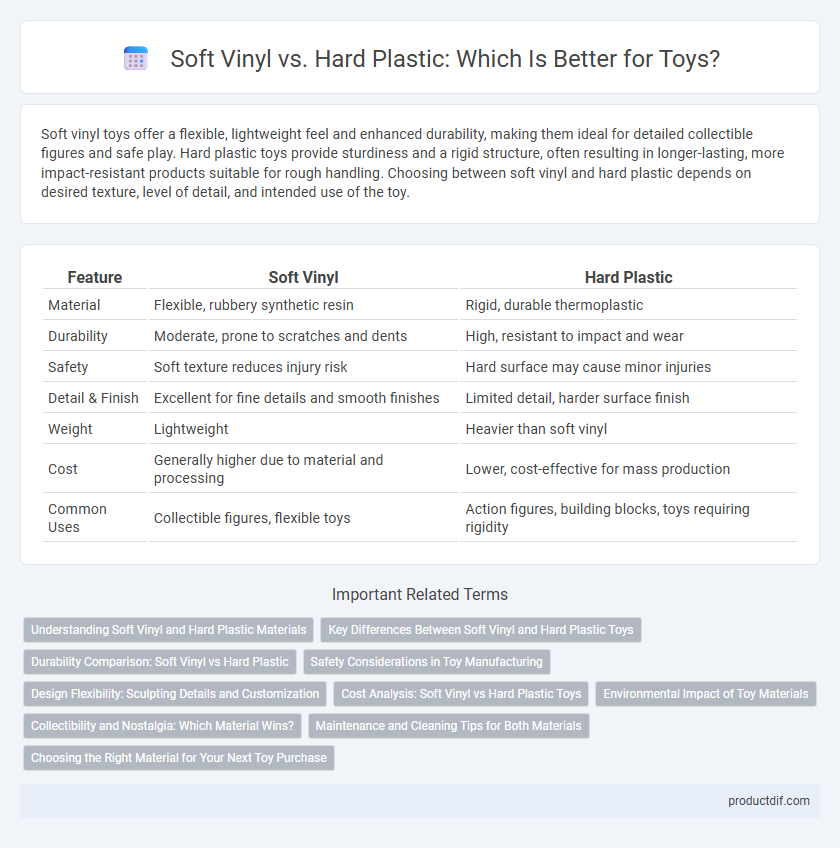Soft vinyl toys offer a flexible, lightweight feel and enhanced durability, making them ideal for detailed collectible figures and safe play. Hard plastic toys provide sturdiness and a rigid structure, often resulting in longer-lasting, more impact-resistant products suitable for rough handling. Choosing between soft vinyl and hard plastic depends on desired texture, level of detail, and intended use of the toy.
Table of Comparison
| Feature | Soft Vinyl | Hard Plastic |
|---|---|---|
| Material | Flexible, rubbery synthetic resin | Rigid, durable thermoplastic |
| Durability | Moderate, prone to scratches and dents | High, resistant to impact and wear |
| Safety | Soft texture reduces injury risk | Hard surface may cause minor injuries |
| Detail & Finish | Excellent for fine details and smooth finishes | Limited detail, harder surface finish |
| Weight | Lightweight | Heavier than soft vinyl |
| Cost | Generally higher due to material and processing | Lower, cost-effective for mass production |
| Common Uses | Collectible figures, flexible toys | Action figures, building blocks, toys requiring rigidity |
Understanding Soft Vinyl and Hard Plastic Materials
Soft vinyl toys offer flexibility and a smooth, tactile feel due to their pliable, rubber-like texture, making them ideal for collectible figures and detailed sculptures. Hard plastic toys, typically made from materials like ABS or PVC, provide durability and rigid structure, perfect for action figures and playsets requiring sturdiness. Understanding these material properties helps consumers choose toys based on desired flexibility, texture, and durability.
Key Differences Between Soft Vinyl and Hard Plastic Toys
Soft vinyl toys are highly flexible, lightweight, and resistant to impacts, making them ideal for collectible figures and detailed designs. Hard plastic toys offer greater durability and structural rigidity, suited for action figures and toys requiring more robust construction. The choice between soft vinyl and hard plastic largely depends on the desired texture, durability, and level of detail in the toy.
Durability Comparison: Soft Vinyl vs Hard Plastic
Soft vinyl toys offer greater flexibility and resistance to impact, reducing the likelihood of cracks or breaks, which enhances their durability in rough play environments. Hard plastic toys provide superior structural strength and scratch resistance, making them ideal for maintaining form under heavy use but can become brittle over time. Both materials balance durability differently, with soft vinyl excelling in shock absorption and hard plastic in rigidity and long-term wear resistance.
Safety Considerations in Toy Manufacturing
Soft vinyl toys offer superior safety due to their flexibility and reduced risk of breaking into sharp pieces, making them ideal for young children. Hard plastic, while durable and rigid, can pose safety hazards if broken, leading to sharp edges that may cause injury. Manufacturers prioritize non-toxic, BPA-free materials and thorough safety testing to ensure both soft vinyl and hard plastic toys comply with international safety standards.
Design Flexibility: Sculpting Details and Customization
Soft vinyl offers superior design flexibility compared to hard plastic, allowing intricate sculpting details and smooth curves that enhance the toy's aesthetic appeal. Its pliable nature facilitates easier customization, including painting and modification, making it a preferred choice for artists and collectors. In contrast, hard plastic tends to be rigid and less adaptable, limiting detailed sculpting and personalization opportunities.
Cost Analysis: Soft Vinyl vs Hard Plastic Toys
Soft vinyl toys generally have a higher production cost due to the complexity of molding and material expenses, but they offer enhanced durability and flexibility compared to hard plastic toys. Hard plastic toys are typically cheaper to manufacture, making them a cost-effective option for mass production, though they may sacrifice some detail and resilience. Evaluating cost analysis between soft vinyl and hard plastic toys involves balancing upfront manufacturing expenses with long-term durability and consumer appeal.
Environmental Impact of Toy Materials
Soft vinyl toys often contain phthalates and other plasticizers that can leach harmful chemicals into the environment during production and disposal, posing significant ecological risks. In contrast, hard plastic toys, typically made from polyethylene or polypropylene, have a lower chemical hazard but contribute heavily to plastic pollution due to their resistance to biodegradation. Both materials require improved recycling methods and sustainable alternatives to reduce long-term environmental impact.
Collectibility and Nostalgia: Which Material Wins?
Soft vinyl toys often hold greater collectibility due to their limited production runs and unique artistic designs, appealing strongly to nostalgic collectors. Hard plastic toys, known for durability and mass-market appeal, typically evoke childhood memories but may lack the exclusivity that drives high-value collections. Collectors prioritize soft vinyl for its tactile feel and rarity, making it the preferred material for nostalgic investment.
Maintenance and Cleaning Tips for Both Materials
Soft vinyl toys require gentle cleaning with a damp cloth and mild soap to avoid surface damage, while hard plastic toys can withstand more rigorous scrubbing and even disinfecting with alcohol-based wipes. Avoid using harsh chemicals on soft vinyl as they can cause discoloration or deformation, whereas hard plastic tolerates stronger cleaning agents without deterioration. Regular dusting and immediate removal of stains help maintain both materials' appearance and longevity.
Choosing the Right Material for Your Next Toy Purchase
Soft vinyl toys offer flexibility, a smooth finish, and a lightweight feel, making them ideal for collectible figures and toys requiring subtle detail. Hard plastic toys provide durability and sturdiness, perfect for active play and long-lasting use in action figures or building blocks. Assess the toy's intended use and target age group to choose between the softness of vinyl and the robustness of hard plastic for optimal safety and performance.
Soft vinyl vs Hard plastic Infographic

 productdif.com
productdif.com